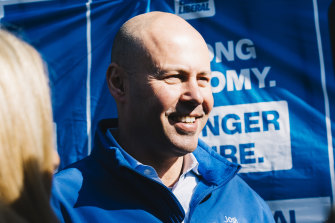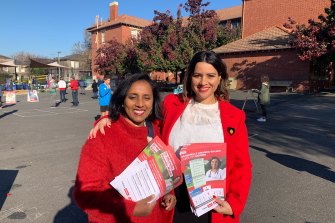Federal election 2022
A generation of high-profile Victorian Liberal Party figures – including Treasurer Josh Frydenberg – are at risk of losing their seats in a major setback for the party that is already triggering bitter recriminations.
Goldstein MP Tim Wilson and Higgins MP Katie Allen were all on track to lose their seats on Saturday night, while Frydenberg and Assistant Treasurer Michael Sukkar’s electoral futures remained uncertain.
“While it’s mathematically possible [to win], it’s difficult,” Frydenberg told his supporters late Saturday night.
In the previously safe Liberal seat of Aston, embattled cabinet minister Alan Tudge was not assured of victory, and in Menzies, a Liberal heartland electorate named after the party’s founder, candidate Keith Wolahan was trailing his Labor opponent by a slim margin on a two-party preferred basis.
One senior Liberal campaigner in Menzies said the result would come down to postal votes but it was likely Wolahan, who is replacing outgoing MP Kevin Andrews, would hold on in an extremely tight contest.
“He’s going to be one of our few MPs in Victoria,” the campaigner said.
Across the state, the electorate appeared to be delivering a significant repudiation to the two big parties in Victoria, mirroring a national trend as the Greens, independents and Clive Palmer’s United Australia Party all recorded gains.
Treasurer Josh Frydenberg was set to lose his seat of Kooyong on Saturday night after a tumultuous campaign against independent Monique Ryan.Credit:Getty Images
The Liberal Party’s Victorian primary vote had dropped 5.5 per cent, with Labor’s down 5.3 per cent compared with the 2019 election. That suggested relatively little change in the state’s two-party preferred vote.
But the state results also suggested that, unlike in previous elections, Victoria is proving decisive to the national result.
The Liberals were banking on a protest vote in Victoria after the state’s many lockdowns, but Liberal Senator Jane Hume has reflected that it was “a miscalculation on our behalf”.
With growing swings to independents and Labor in Victoria, Hume told Nine: “We thought there would be a bigger Dan Andrews effect in Victoria and there hasn’t, which I find disappointing.”
“We have had such negative feedback about those harsh lockdowns in Victoria, and we thought that may play out in those outer suburban areas. Clearly, they haven’t.”
One senior Victorian Liberal who did not want to be named said the Victorian party had been effectively “thrown under a bus” by Prime Minister Scott Morrison, a deeply unpopular figure in the state.
In what would be a major blow to the state arm of the Liberal Party, Frydenberg faced the possibility of losing his affluent inner Melbourne seat of Kooyong on Saturday night.
Simon Holmes a Court, the Climate 200 convener who has partly funded the teal independent candidates, said Kooyong, Goldstein, Wentworth, North Sydney and possibly Mackellar could fall to the teals.
“There’s about 30 per cent counted, and they all look solid,” Holmes a Court told The Age.
“It’s freaking amazing.”
By mid-evening, Frydenberg was trailing teal independent Monique Ryan in two-party preferred terms, with their primary votes almost even at about 41.5 per cent.
Kooyong was once considered the jewel in the Liberal Party’s crown, as the former seat of Liberal founder and long-serving prime minister Robert Menzies, as well as Liberal leader Andrew Peacock.
But Frydenberg has faced attacks from multiple angles, with claims he abandoned Victoria during the state’s long lockdowns of 2020 and 2021.
The Labor Party remains on track to wrest the once-blue-ribbon seat of Higgins – the seat of former treasurer Peter Costello – following a collapse in the incumbent Katie Allen’s primary vote.
Early results showed Labor’s Michelle Ananda-Rajah ahead 53.3 per cent on a two-party preferred basis, with 64 per cent of votes counted.
Labor’s Michelle Ananda-Rajah was leading in the marginal seat of Higgins last night.Credit:Mathew Dunckley
A Labor source said: “Feeling very good about Chisholm. Deakin optimistic. And Higgins looking good.”
Assistant Treasurer Michael Sukkar was also in danger of losing the seat of Deakin, in Melbourne’s east. With 45 per cent counted, Sukkar was trailing Labor’s Matt Gregg at 49.6 to 50.4 per cent in two-party preferred terms.
Labor was also set to win Chisholm, in Melbourne’s east, with Carina Garland ahead of Liberal incumbent Gladys Liu.
The Liberal Party’s hopes of winning back the coastal electorate of Corangamite also faded early in the evening as the Labor incumbent steamed ahead.
Some Liberals regarded Corangamite as the party’s best chance of taking a seat from Labor in Victoria and Scott Morrison made multiple trips to the electorate throughout the campaign.
With 50 per cent counted, Labor’s Libby Coker was leading Liberal challenger Stephanie Asher 58.1 to 41.9 per cent.
The electorate, which includes parts of Geelong, Surf Coast and Bellarine Peninsula, was among the most marginal electorates in Victoria, which Labor held by about 1 per cent in 2019.
Residents in the electorate have grappled with rapid urbanisation in its suburbs and coastal towns, and population growth was among the biggest issues during the election.
In the northern Victorian seat of Indi, independent Helen Haines easily retained her seat.
“Ladies and gentlemen, I am proud to be back,” she declared to rapturous applause from her orange-clad supporters.
Labor has increased its two-party-preferred result in Victoria for the past three elections. In 2013, it won 50.2 per cent of the two-party-preferred Victorian vote, with 19 out of 37 seats.
That increased to 51.8 per cent in 2016, although Labor slipped on the seat count, with 18 out of 37 seats.
But in 2019, Labor won 53.1 per cent of the two-party preferred count, lifting its seats by 3 to 21 out of 38 seats.
Victoria has previously been seen as tangential to the political action, with both sides focusing their attention elsewhere, particularly Queensland and Western Sydney. However, this election has been different, with a number of Victorian seats seen as crucial to the result.
At the last federal election, the Coalition won just 15 out of 38 Victorian seats (with 47 per cent of the two-party-preferred vote), compared with 23 out of 30 Queensland seats and 11 out of 16 Western Australian seats.
Cut through the noise of the federal election campaign with news, views and expert analysis from Jacqueline Maley. Sign up to our Australia Votes 2022 newsletter here.
Most Viewed in Politics
From our partners
Source: Read Full Article




